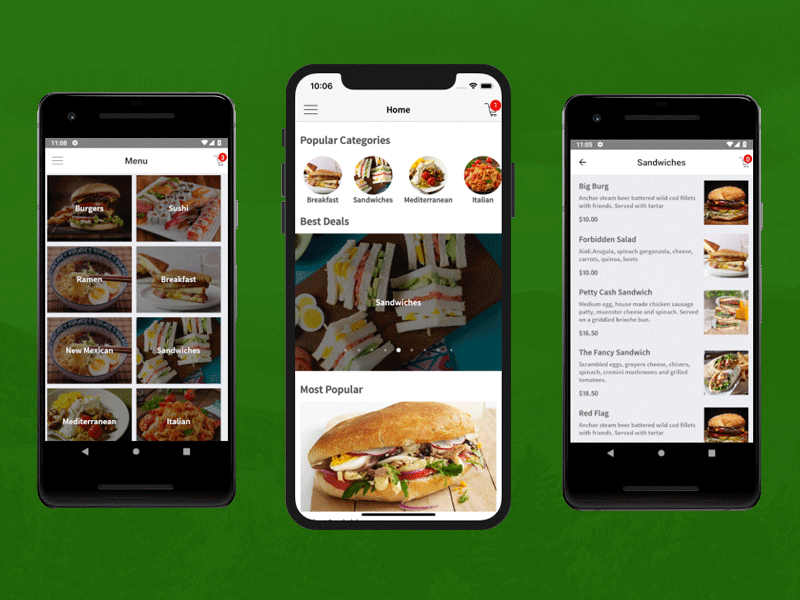How to Build a Great On-demand Food-Delivery App in 2020?
Food is a very essential part of life for all kinds of people. With today’s advanced technology and busy lifestyle, people find it more convenient to order food online. With the increase in usage of smart phones and unlimited internet access, people are more attracted to any service, which has the flexibility of time, ease of access and less time-consuming. This is the reason why online food delivery applications are getting more traffic than other mobile app development services.
It is not a child’s play to create a food-delivery business via online application. Starting from managing resources to analyzing customer requirements, there are a lot of decisions and back work to be done. Getting a high-tech mobile application firm to create a flawless application for your business is not step one. You need to analyze the model of your business, understand your customers, look out for competitors and so on.
Let us look at some of the ways on how to build a great on-demand food delivery app in 2020:
1) Identifying the right business model –
According to industry trends, there are two major business models that would suit an online food-delivery application.
2) Aggregator business model –
According to this model, your company would be a liaison third-party element in the workflow. Your job is to connect the customers with the restaurant and vice-versa. Under this model, your application should provide customers with a lot of options in terms of restaurants, cuisines, combo offers and so on. Your customers should be able to surf menus of different restaurants sorted by distance from delivery location, type of food, price and so on. Once the order is placed, you would be sending the order details to the restaurant and when the food is ready, your dispatch unit would receive the food from the restaurant and delivery it to the customer. Your customer and the restaurants would not communicate directly at any point in this business transaction.
Also Read: Top 14 Cross Platform App Development Tools
3) Logistic support model –
Under this model, you would take care of the ordering and the restaurant will take care of delivery, vehicle maintenance, and others.
Different panels of your food-delivery app –
- You need a simple customer application with a list of restaurants, pictures of the dishes, shopping cart, offer pages and so on.
- On the other hand, you need an administration panel for your team to manage the food requests.
- The restaurants should have a panel to access the food orders and indicate the time of order completion and other related information.
- You need a courier app to link the food orders to each person of the delivery team.
All these panels should be able to communicate 24/7 with each other. If there is any break in this link, your customers would not receive their orders in time and you would lose reputation.
4) Steps for creating the best food-delivery application –
- Talk with a mobile application service provider to create a basic model of the application. This step would require brainstorming to determine the basic operation of the application.
- Create a database of restaurants, their menu, specialty items and so on. This database should be updated from time to time. Add pictures of the products to create an appealing look.
- Create a taskmaster for your delivery team. This will help to track the movement of your team.
- A prototype model will be generated by the service provider. You need to test it with beta testers. Liaison with some local restaurants for free of cost to test your application.
- Advertise your application to restaurant owners and customers.
- Have a quality control team to determine the pros and cons of each element of the app at each stage of development.
5) Top elements to add in the customer panel –
- Registration tab, with link to online payment preference, food preference, profile photo, and other personalization effects.
- List of restaurants sorted in accordance with location, cuisine, cost, and others. The customers should be able to type and search for a restaurant or dish
- GPS location tracker with the ability to list the restaurants closer to the customer and average time take for closing a delivery.
- Shopping cart styled selection system for customers to choose dishes of varying type and quality from different restaurants at the same time.
- High-security payment gateway with numerous payment options
- Delivery location setter and option to track the order, call the delivery boy and so on.
- A dedicated page for review and rating of food, delivery, and the application.
6) Background panel of the food-delivery app –
- Registration for each delivery boy, link to the food delivery address and pickup restaurant address. Option to opt-in or out of a delivery task
- Contact information of restaurant and customers
- Route towards the destinations
7) Restaurant panel of the food-delivery app –
- A panel to see the order, forward it to other departments, indicate completion of the order and so on.
- Option to add or remove an item for the menu of the restaurant in the app.
- Payment receiving option (according to your business model).
This is just a prototype of how a basic food-delivery app should be. You ought to make unique changes in it to create a strategic stance for your business in today’s market. It is always best to create ease for customers and improve the quality of the process to attract more customers.
Author Bio:
Chanchal Soni works as a Digital and Content Marketing Specialist at SoftwareSuggest, an online platform that recommends software solutions to businesses. Her area of expertise include mobile app development. In her spare time, she likes to reading and travelling.
Also Read: 5 Trends That Define Future of Android App Development






